Vsc Lexus IS250 2006 Audio/video System / LEXUS 2006 IS350/250 FROM MAY 2006 PROD. OWNER'S MANUAL (OM53619U)
[x] Cancel search | Manufacturer: LEXUS, Model Year: 2006, Model line: IS250, Model: Lexus IS250 2006Pages: 437, PDF Size: 11.01 MB
Page 145 of 437
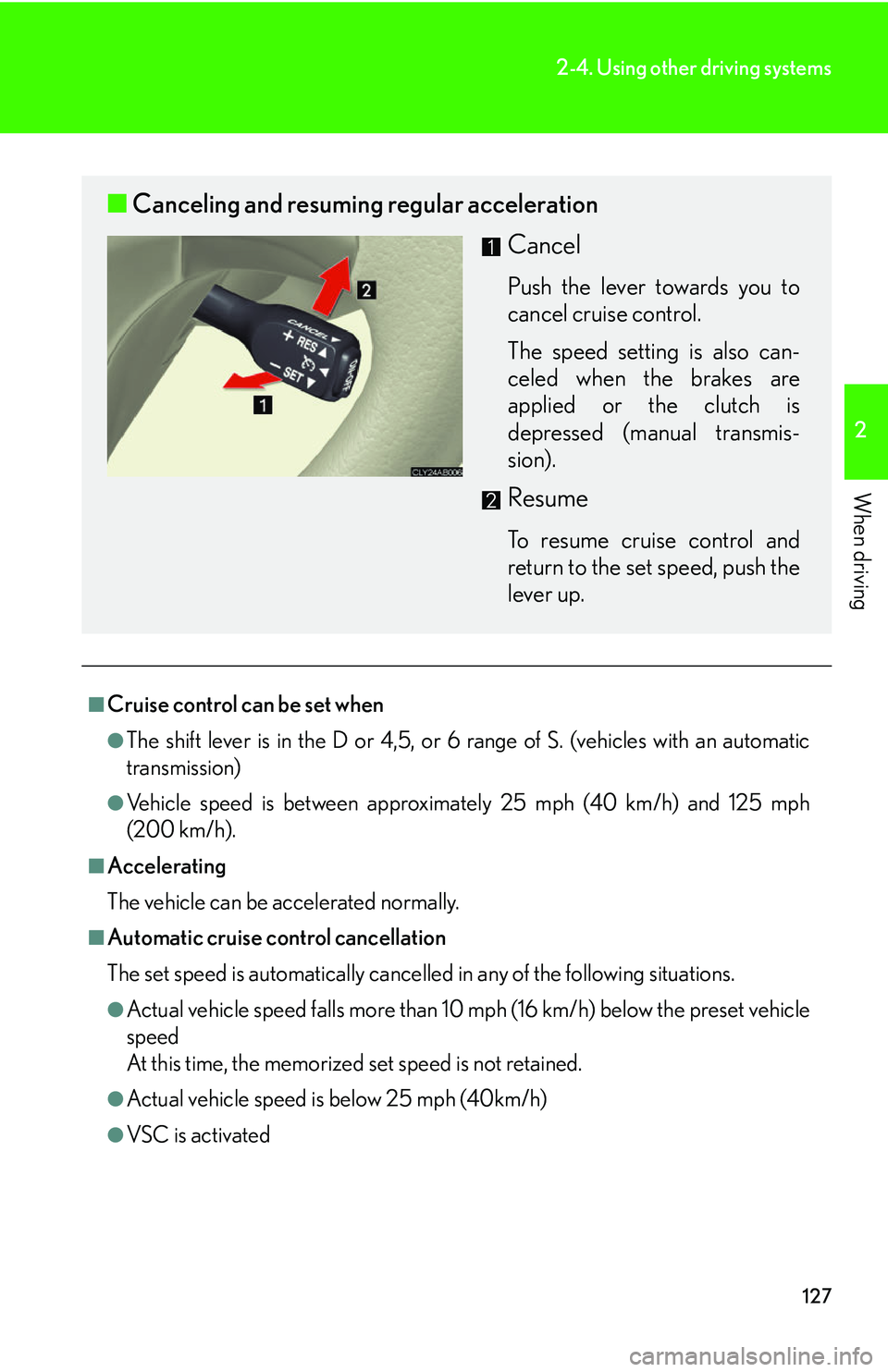
127
2-4. Using other driving systems
2
When driving
■Cruise control can be set when
●The shift lever is in the D or 4,5, or 6 range of S. (vehicles with an automatic
transmission)
●Vehicle speed is between approximately 25 mph (40 km/h) and 125 mph
(200 km/h).
■Accelerating
The vehicle can be accelerated normally.
■Automatic cruise control cancellation
The set speed is automatically cancelled in any of the following situations.
●Actual vehicle speed falls more than 10 mph (16 km/h) below the preset vehicle
speed
At this time, the memorized set speed is not retained.
●Actual vehicle speed is below 25 mph (40km/h)
●VSC is activated
■Canceling and resuming regular acceleration
Cancel
Push the lever towards you to
cancel cruise control.
The speed setting is also can-
celed when the brakes are
applied or the clutch is
depressed (manual transmis-
sion).
Resume
To resume cruise control and
return to the set speed, push the
lever up.
Page 151 of 437
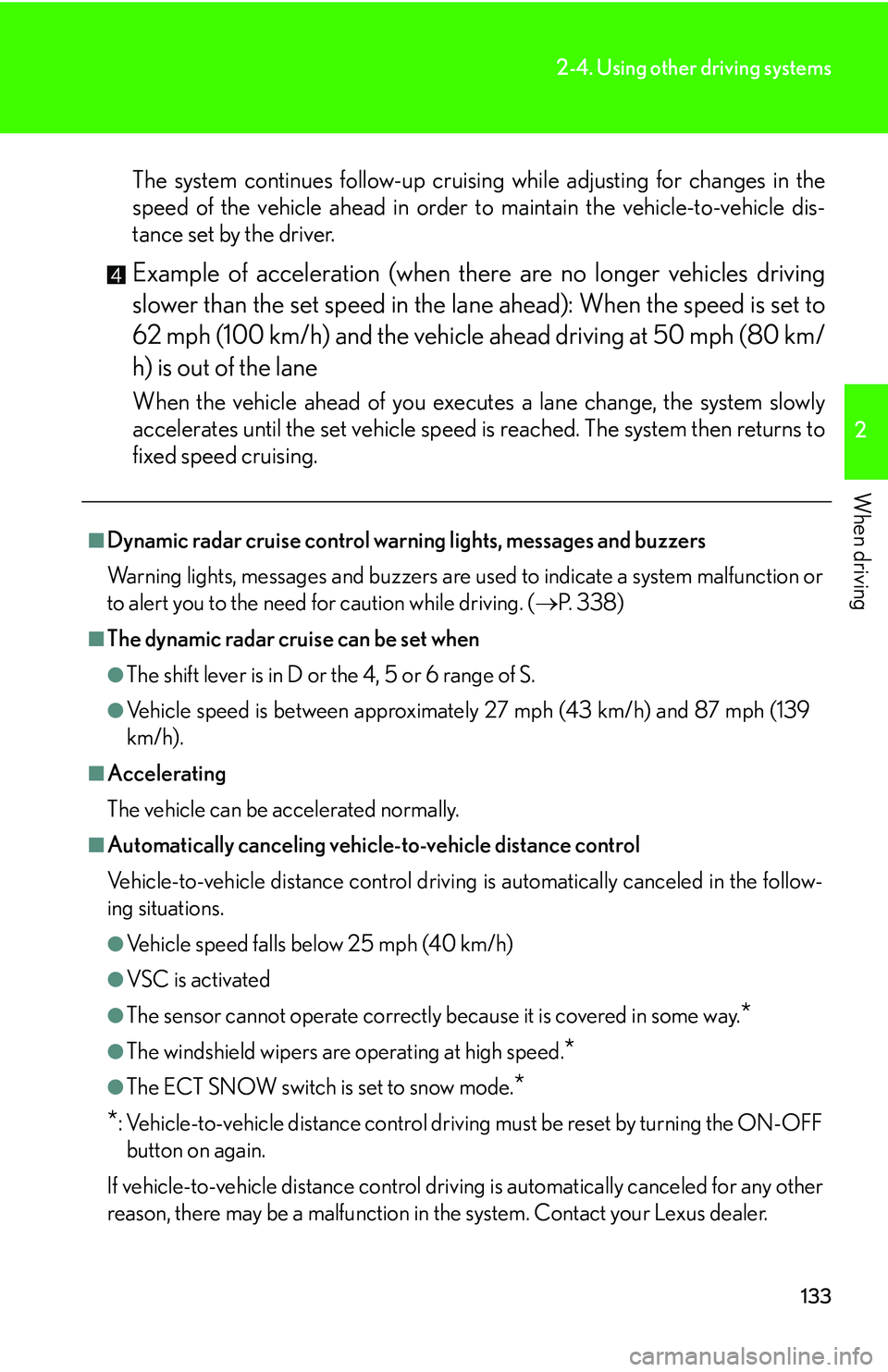
133
2-4. Using other driving systems
2
When driving
The system continues follow-up cruising while adjusting for changes in the
speed of the vehicle ahead in order to maintain the vehicle-to-vehicle dis-
tance set by the driver.
Example of acceleration (when ther e are no longer vehicles driving
slower than the set speed in the lane ahead): When the speed is set to
62 mph (100 km/h) and the vehicle ahead driving at 50 mph (80 km/
h) is out of the lane
When the vehicle ahead of you executes a lane change, the system slowly
accelerates until the set vehicle speed is reached. The system then returns to
fixed speed cruising.
■Dynamic radar cruise control warning lights, messages and buzzers
Warning lights, messages and buzzers are us ed to indicate a system malfunction or
to alert you to the need for caution while driving. ( P. 3 3 8 )
■The dynamic radar cruise can be set when
●The shift lever is in D or the 4, 5 or 6 range of S.
●Vehicle speed is between approximately 27 mph (43 km/h) and 87 mph (139
km/h).
■Accelerating
The vehicle can be accelerated normally.
■Automatically canceling vehicle-to-vehicle distance control
Vehicle-to-vehicle distance control driving is automatically canceled in the follow-
ing situations.
●Vehicle speed falls below 25 mph (40 km/h)
●VSC is activated
●The sensor cannot operate correctly because it is covered in some way.*
●The windshield wipers are operating at high speed.*
●The ECT SNOW switch is set to snow mode.*
*
: Vehicle-to-vehicle distance control driving must be reset by turning the ON-OFF button on again.
If vehicle-to-vehicle distance control driving is automatically canceled for any other
reason, there may be a malfunction in the system. Contact your Lexus dealer.
Page 152 of 437

134
2-4. Using other driving systems
■Automatically cancelling constant speed control
The set speed is automatically canceled in the following situations.
●Actual vehicle speed is more than 10 mph (16 km/h) below the preset vehicle
speed
At this time, the memorized set speed is not retained.
●Vehicle speed falls below 25 mph (40 km/h)
●VSC is activated
■Vehicle-to-vehicle distance settings
Select a distance from the table below. Note that the distances shown correspond
to a vehicle speed of 50 mph (80 km/h). Vehicle-to-vehicle distance increases/
decreases in accordance with vehicle speed.
■Radar sensor and grille cover
Always keep the sensor and grille cover clean to ensure that the vehicle-to-vehicle
distance control operates properly. (Some obstructions, such as snow, ice or plastic
objects, cannot be detected by the obstruction sensor.)
Dynamic radar cruise control is canc eled if an obstruction is detected.
Distance optionsVehicle-to-vehicle distance
LongApproximately 164 f t. (50 m)
MediumApproximately 132 ft. (40 m)
ShortApproximately 100 f t. (30 m)
Grille cover
Radar sensor
Page 162 of 437
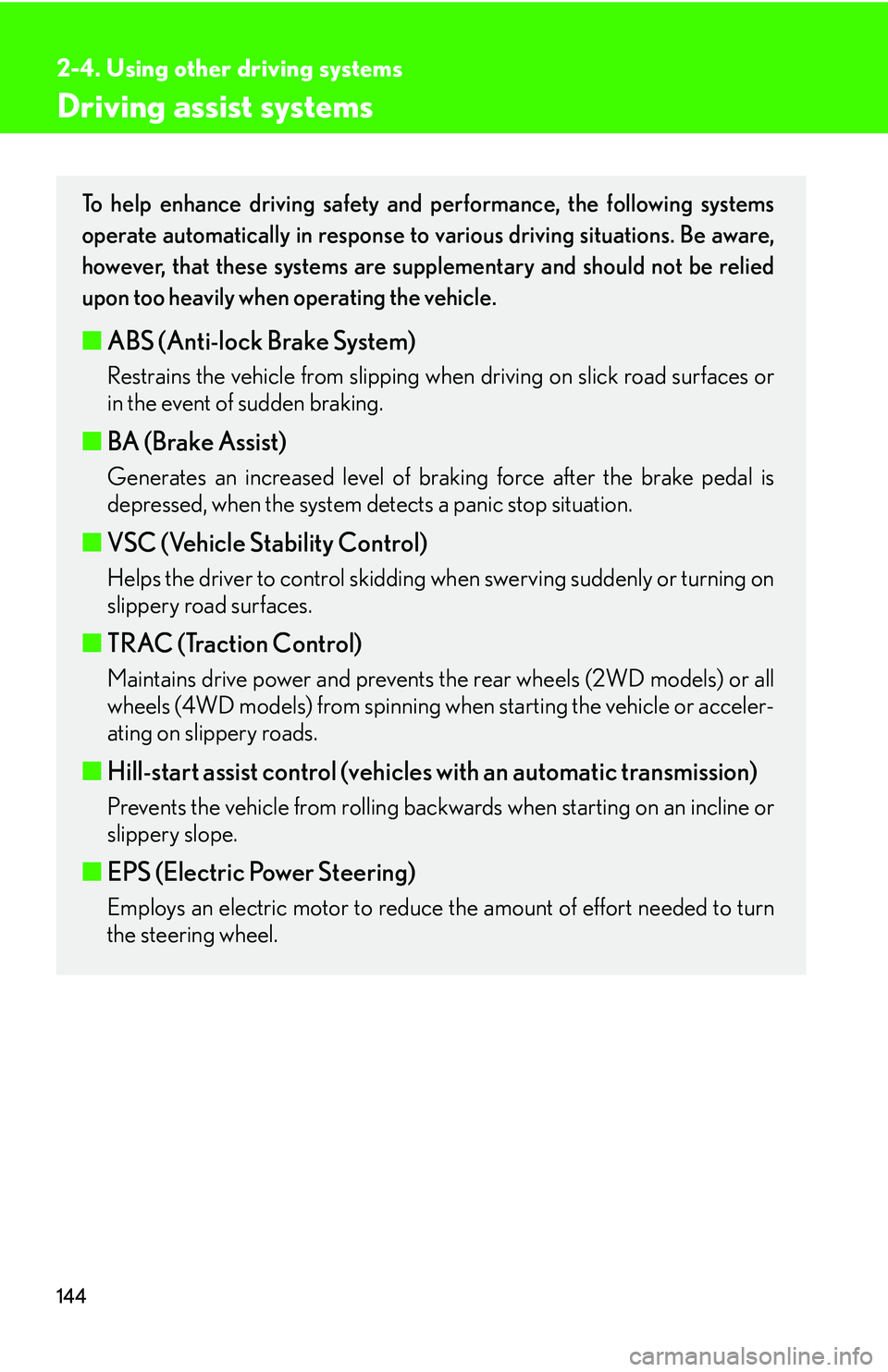
144
2-4. Using other driving systems
Driving assist systems
To help enhance driving safety and performance, the following systems
operate automatically in response to various driving situations. Be aware,
however, that these systems are supplementary and should not be relied
upon too heavily when operating the vehicle.
■ABS (Anti-lock Brake System)
Restrains the vehicle from slipping when driving on slick road surfaces or
in the event of sudden braking.
■BA (Brake Assist)
Generates an increased level of braking force after the brake pedal is
depressed, when the system detects a panic stop situation.
■VSC (Vehicle Stability Control)
Helps the driver to control skidding when swerving suddenly or turning on
slippery road surfaces.
■ TRAC (Traction Control)
Maintains drive power and prevents th e rear wheels (2WD models) or all
wheels (4WD models) from spinning when starting the vehicle or acceler-
ating on slippery roads.
■ Hill-start assist control (vehicles with an automatic transmission)
Prevents the vehicle from rolling backwa rds when starting on an incline or
slippery slope.
■ EPS (Electric Power Steering)
Employs an electric motor to reduce the amount of effort needed to turn
the steering wheel.
Page 163 of 437

145
2-4. Using other driving systems
2
When drivingWhen the VSC/TRAC/hill-start assist control systems are operating
If the vehicle is in danger of slip-
ping, rolling backwards when
starting on an incline, or if the rear
wheels (2WD) or 4 wheels
(4WD) spin, the slip indicator light
flashes to indicate that the VSC/
TRAC/hill-start assist control sys-
tems have been engaged.
A buzzer (intermittent) sounds to
indicate that VSC is operating.
The stop lights and high mounted
stoplight turn on when the hill-start
assist control system is operating.
■VDIM (Vehicle Dynamics Integrated Management) (IS350)
Provides integrated control of the ABS, BA, TRAC, VSC, hill-start assist
control, and EPS systems.
Maintains vehicle stability when swerving on slippery road surfaces by
controlling the brakes and engine output.
■ PCS (Pre-Collision System) (if equipped)
P. 1 4 9
Page 164 of 437
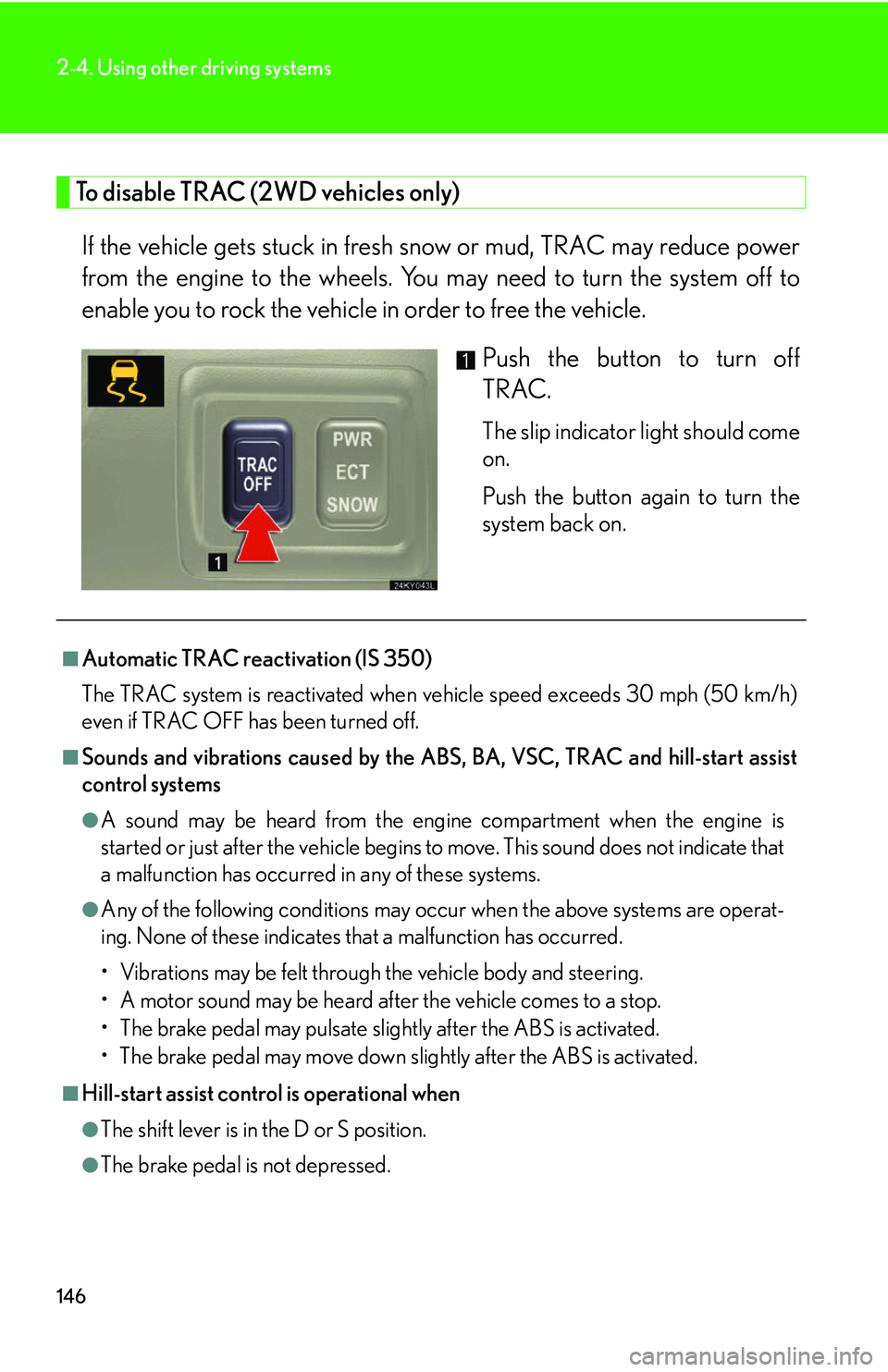
146
2-4. Using other driving systems
To disable TRAC (2WD vehicles only) If the vehicle gets stuck in fresh sn ow or mud, TRAC may reduce power
from the engine to the wheels. You may need to turn the system off to
enable you to rock the vehicle in order to free the vehicle.
Push the button to turn off
TRAC.
The slip indicator light should come
on.
Push the button again to turn the
system back on.
■Automatic TRAC reactivation (IS 350)
The TRAC system is reactivated when vehicle speed exceeds 30 mph (50 km/h)
even if TRAC OFF has been turned off.
■Sounds and vibrations caused by the ABS, BA, VSC, TRAC and hill-start assist
control systems
●A sound may be heard from the engine compartment when the engine is
started or just after the vehicle begins to move. This sound does not indicate that
a malfunction has occurred in any of these systems.
●Any of the following conditions may occur when the above systems are operat-
ing. None of these indicates that a malfunction has occurred.
• Vibrations may be felt through the vehicle body and steering.
• A motor sound may be heard after the vehicle comes to a stop.
• The brake pedal may pulsate slightly after the ABS is activated.
• The brake pedal may move down slightly after the ABS is activated.
■Hill-start assist control is operational when
●The shift lever is in the D or S position.
●The brake pedal is not depressed.
Page 166 of 437

148
2-4. Using other driving systems
CAUTION
■Replacing tires
Make sure that all tires are of the same size, brand, tread pattern and total load
capacity. In addition, make sure that the tires are inflated to the recommended tire
pressure level.
The ABS and VSC systems will not function correctly if different tires are fitted on
the vehicle.
Contact your Lexus dealer for further info rmation when replacing tires or wheels.
■Handling of tires and suspension
Using tires with any kind of problem or modifying the suspension will affect the driv-
ing assist systems, and may cause the system to malfunction.
Page 322 of 437
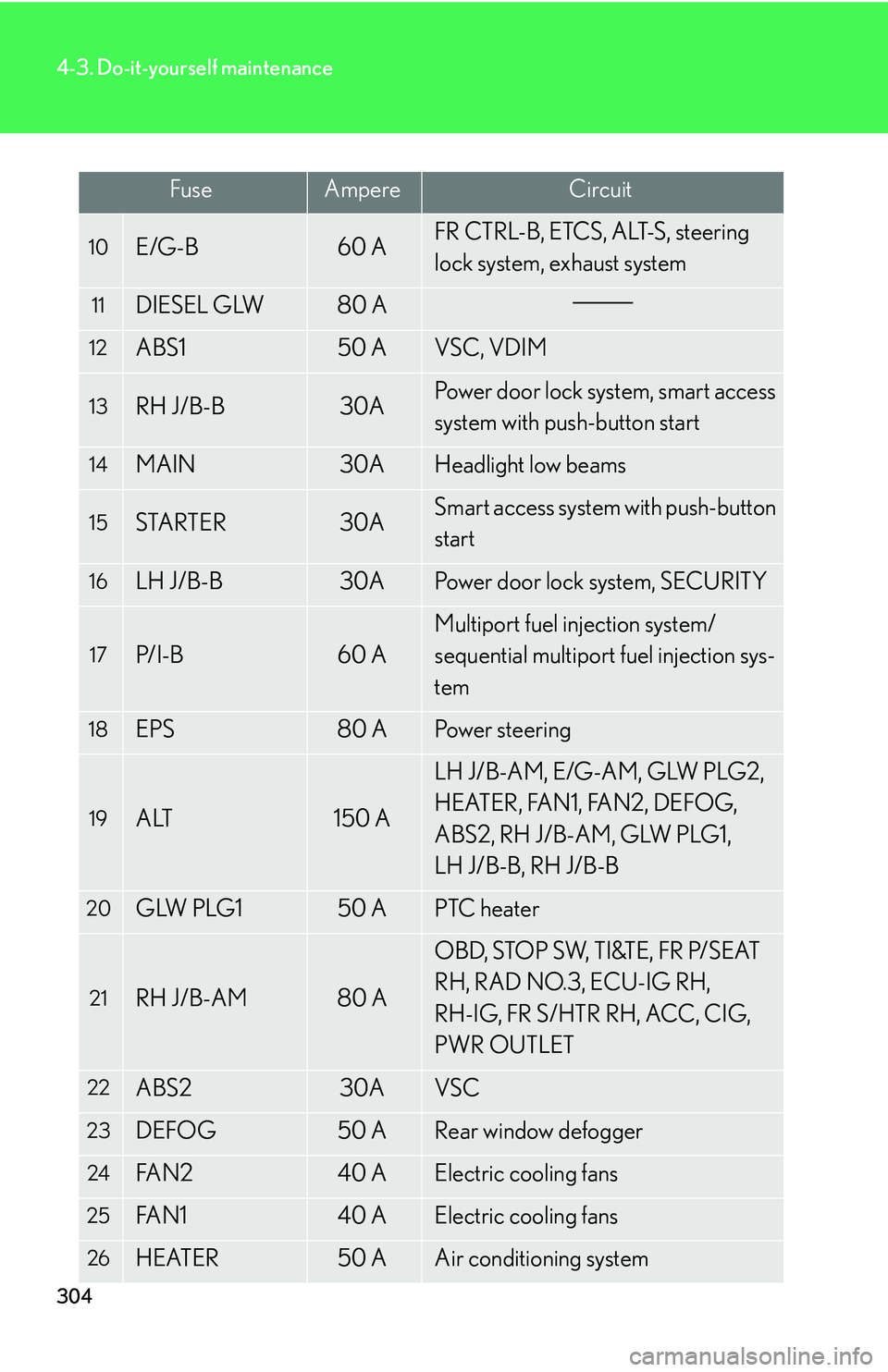
304
4-3. Do-it-yourself maintenance
FuseAmpereCircuit
10E/G-B60 AFR CTRL-B, ETCS, ALT-S, steering
lock system, exhaust system
11DIESEL GLW80 A
12ABS150 AVSC, VDIM
13RH J/B-B30APower door lock system, smart access
system with push-button start
14MAIN30AHeadlight low beams
15STARTER30ASmart access system with push-button
start
16LH J/B-B30APower door lock system, SECURITY
17P/I-B60 A
Multiport fuel injection system/
sequential multiport fuel injection sys-
tem
18EPS80 APower steering
19ALT150 A
LH J/B-AM, E/G-AM, GLW PLG2,
H E AT E R , FA N 1 , FA N 2 , D E F O G,
ABS2, RH J/B-AM, GLW PLG1,
LH J/B-B, RH J/B-B
20GLW PLG150 APTC heater
21RH J/B-AM80 A
OBD, STOP SW, TI&TE, FR P/SEAT
RH, RAD NO.3, ECU-IG RH,
RH-IG, FR S/HTR RH, ACC, CIG,
PWR OUTLET
22ABS230AVSC
23DEFOG50 ARear window defogger
24FA N 240 AElectric cooling fans
25FA N 140 AElectric cooling fans
26HEATER50 AAir conditioning system
Page 329 of 437
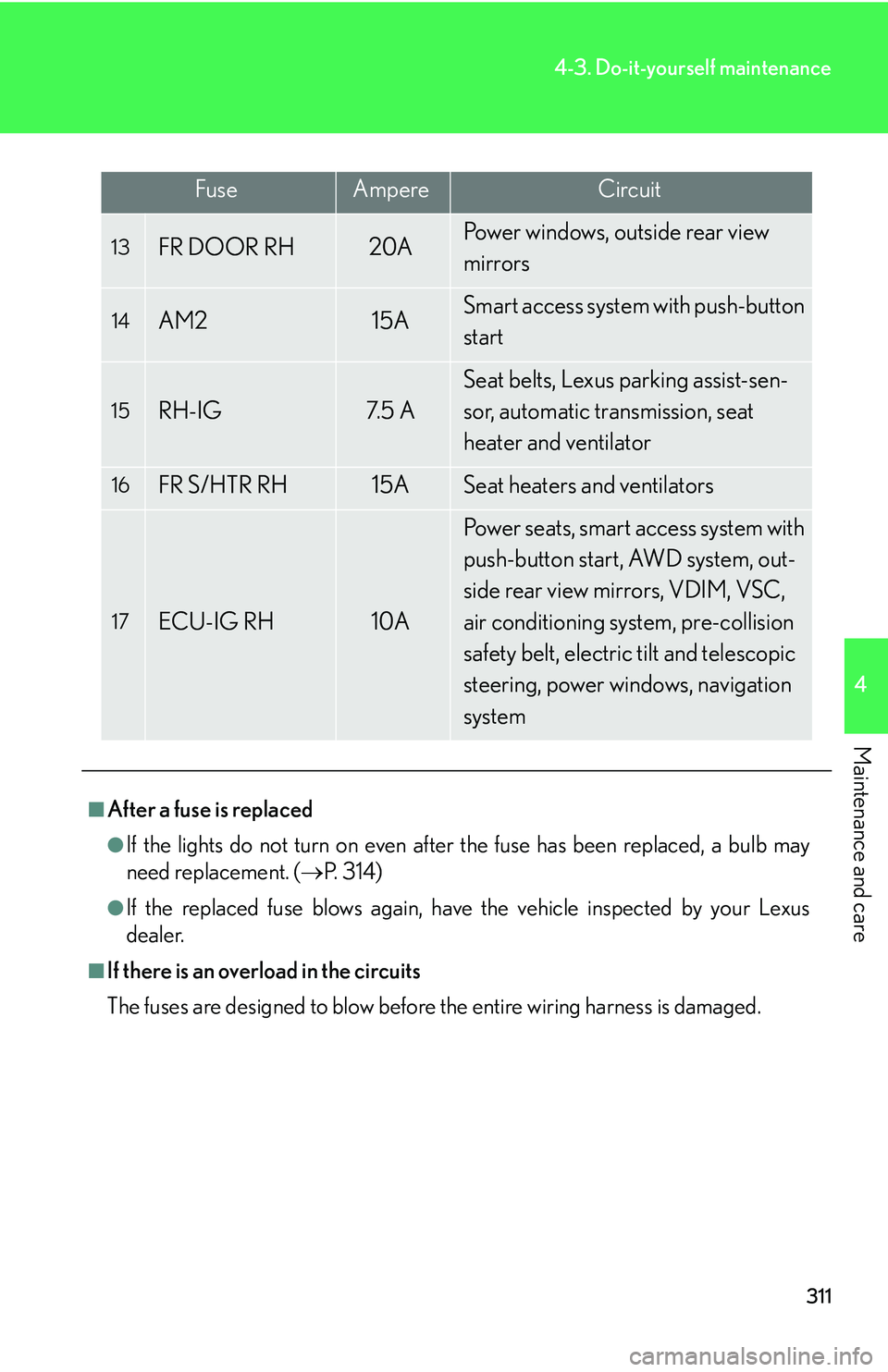
311
4-3. Do-it-yourself maintenance
4
Maintenance and care
FuseAmpereCircuit
13FR DOOR RH20APower windows, outside rear view
mirrors
14AM215ASmart access system with push-button
start
15RH-IG7. 5 A
Seat belts, Lexus parking assist-sen-
sor, automatic transmission, seat
heater and ventilator
16FR S/HTR RH15ASeat heaters and ventilators
17ECU-IG RH10A
Power seats, smart access system with
push-button start, AWD system, out-
side rear view mirrors, VDIM, VSC,
air conditioning system, pre-collision
safety belt, electric tilt and telescopic
steering, power windows, navigation
system
■After a fuse is replaced
●If the lights do not turn on even after the fuse has been replaced, a bulb may
need replacement. ( P. 3 1 4 )
●If the replaced fuse blows again, have the vehicle inspected by your Lexus
dealer.
■If there is an overload in the circuits
The fuses are designed to blow before the entire wiring harness is damaged.
Page 349 of 437

5
When trouble arises
331
5-1. Essential information
Event data recorder
In a crash or a near car crash eventThe SRS airbag sensor assembly cont ains the EDR. In a crash or a near
car crash event, this devic e may record some or all of the following infor-
mation:
● Engine speed
● Whether the brake pedal was applied or not
● Vehicle speed
● To what extent the accelerator pedal was depressed
● Position of the transmission shift lever
● Whether the driver and front passenger wore seat belts or not
● Driver's seat position
● SRS airbag deployment data
● SRS airbag system diagnostic data
If your vehicles is equipped with a vehicle stability control (VSC) system
The VSC Electronic Control Unit (ECU) may contain another EDR. In
case the VSC or Brake Assist system is activated, or the lateral accelera-
tion is beyond a certain valve, this device may record some or all of the
following information:
● Behavior of the vehicle
● Steering wheel angle
Your vehicle has computers that monitor and control certain aspects of
your vehicle. These computers assist in driving and maintaining optimal
vehicle performance.
Besides storing data usef ul for troubleshooting, there is an event data
recorder (EDR) that records data in a crash or a near car crash event.